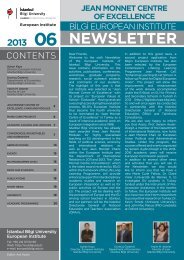WP2 Turkey: Country Report - İstanbul Bilgi Üniversitesi | AB Enstitüsü
WP2 Turkey: Country Report - İstanbul Bilgi Üniversitesi | AB Enstitüsü
WP2 Turkey: Country Report - İstanbul Bilgi Üniversitesi | AB Enstitüsü
Create successful ePaper yourself
Turn your PDF publications into a flip-book with our unique Google optimized e-Paper software.
Social Impact of Emigration and Rural-Urban Migration in Central and Eastern Europe<br />
VT/2010/001<br />
rural areas. The second period between 1950 and 1985 is characterized not only by ruralurban<br />
migration, but also by urban-urban migration. The first migration wave of this period<br />
was from the immediate hinterland of the big cities to the big cities such as Istanbul, İzmir<br />
and Ankara. Subsequent wave of migration in this stage was one from Central Anatolia and<br />
Black Sea region to the metropolitan cities. Eventually, the last wave was the migration from<br />
Eastern Anatolia and Southeastern Anatolia to the metropolitan areas of Western Anatolia.<br />
IDPs constitute the third phase of internal migration starting in the second half of the 1980s<br />
and becoming very intensive in the 1990s. These migrants, generally accepted to number<br />
around more than one million, left their rural homes to move to the suburbs of the big cities<br />
as a result of the armed conflict in south-eastern region either through state pressure or out<br />
of fear of staying in the middle of the conflict. The migratory routes of these groups in <strong>Turkey</strong><br />
are subject to their economic and social capital (see Map 1). Those who had a good amount<br />
of economic capital wanted to go to Istanbul, İzmir or Ankara, as far as it could be from the<br />
South East. Those who had less money migrated to places like Mersin at the Mediterranean<br />
Region, where they didn’t have to spend so much money for transportation and for heating in<br />
winter. Eventually, those with no capital had to evacuate their villages to go to the city<br />
centres in the region such as Diyarbakir or Van (Kaya et al., 2009). 10<br />
One should also bear in mind the migration of the Christian minorities residing in the<br />
Southeast Anatolia due to the endemic violence in the region. Severely affected by the<br />
armed conflict and insurgencies as well as terrorist activities of the PKK in south-eastern<br />
<strong>Turkey</strong> in the 1980s and 1990s, the Assyrians migrated to Istanbul first, and from there to<br />
Europe, mostly to Sweden. According to their own statements, the number of Assyrians<br />
decreased to 3,000 in the south-eastern region and to 50,000 in Istanbul. Most of the<br />
Assyrians live in Sweden since they left <strong>Turkey</strong> in the 1970s as either workers or asylum<br />
seekers. Ezidis have also been subject to internal and international mobility due to the same<br />
reason.<br />
2.3. Main Characteristics of Migrants<br />
In the early stages of the migration (1960s), Turkish migrants were mainly men between the<br />
ages of 20 and 39, relatively skilled and educated in comparison to the average working<br />
population in <strong>Turkey</strong>, and from the economically more developed regions of the country<br />
(Abadan-Unat, 1976; Martin, 1991). The share of rural migrants in all migrants at this stage<br />
was just 17.2% (Gökdere, 1978). In the second half of the 1960s, however, recruitment<br />
consisted of low educated rural workers (Gökdere, 1978). Later on, with demands from the<br />
textile and electronics sectors for cheap female labour, it was conversely the women who<br />
first migrated to cities like Berlin in the late 1960s and early 1970s. By and large, most of the<br />
Turkish emigrants originate from Central Anatolia and Black Sea regions (Kaya and Kentel,<br />
2005). Since 1973, the composition of the Turkish migrant population has tended to become<br />
a more general population migration in the form of family reunification and political asylum<br />
rather than mainly labour migration.<br />
As stated above, emigration of skilled people started towards the other countries such as the<br />
USA, Canada and Australia and still continues (Akçapar, 2009; Kaya and Şahin, 2005;<br />
İçduygu, 2009). For instance, the highly skilled and educated profile of the Turkish<br />
community in the USA is changing in the recent years, as unskilled or semi-skilled Turkish<br />
labour workers also arrive in the country. They usually work in restaurants, gas stations,<br />
hairdressers, construction sites, and grocery stores although some of them obtained<br />
American citizenship or green cards and opened their own ethnic businesses (Akçapar,<br />
2009; Kaya, 2003: 58). According to the USA Census 2000, the profile of Turkish people<br />
born in <strong>Turkey</strong> and living in the USA is as follows: 35,025 (44.7%) of them were naturalized<br />
citizens with more than half (21,080) entered the USA before 1980; whereas 43,350 (55.3%)<br />
were not USA citizen with the majority of them (33,030) entered the USA between 1990 and<br />
2000. The gender distribution was 54.7% male (42,880) and 45.3% (35,500) females. As for<br />
ages of the sample data, the majority of them, 19,480 people (24.9%) were between 25 and<br />
34 years old. As for educational attainment, overall 42.7% had a bachelor’s degree or higher<br />
10 This is a common pattern in several IDP situations. See Van Hear (2004).<br />
Final <strong>Country</strong> <strong>Report</strong> <strong>Turkey</strong> 8



